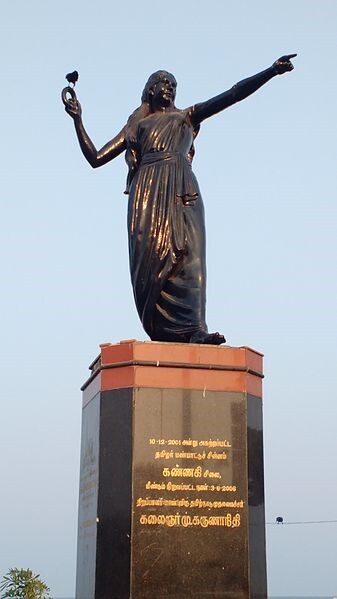

The phrase “The Story of the Anklet,” translated as “Silappadikaram/Cilappatikaran,” alludes to the anklet known as Silambu that young Tamil women without husbands wore in the past and removed on their wedding day. Consequently, Silambu is a representation of virginity and innocence that later served as the symbol of the Pathni sect (the worship of chastity).

Kannagi Statue
Balaji Ravichandran, Kannagi Statue in Marina Beach, CC BY-SA 4.0
Description-Kannagi Statue at Marina Beach, Chennai Tamil Nadu
Although there are many myths about our ancient authors, we don't know very much about them. It would be interesting notion to consider Ilango and Bharata as being the same person who not only created a manual but also gave fiction graphics for it in the form of Silappadikaram.
Heinrich Zimmer asserts that many of the metaphysical and theoretical works published in Sanskrit may have had South Indian writers because Sanskrit served as the major language of communication among Indian intellectuals during the period (1890–1943). As opposed to utilising a linear perspective, we see history as cyclical, making it difficult to date our authors and works using Western conceptions of time.
Is the legendary Silappadikaram a play? It differs from literature in any other Indian language, including Sanskrit, due to this divergence. Ilango, a superb dramatist and creative literary genius, coined the term “Muththamizh viraviya pattudai ceyyul,” a new genre that combines poetry, music, and theatre. Like Shakespeare, he is aware that every term has both dramatic and literary connotations.
A genius may employ words in such a way that, depending on the context, they assume the appropriate literary or dramatic identity, allowing you to interpret it as either poetry or a play. To put it another way, a “literary term” becomes a “dramatic word” when performed on a platform and is visible to the audience.
Ilanko Atikal is believed to be the author of the Cilappatikaran; his name translates as “a Jain saint” or “an ascetic.” Sattanar, the author of the Manimekhalai, is also said to have written the Cilappatikaran.
Kannaki − She is the epic's main character and hero. She is known by the name “Cilapattikaram,” which translates to “The Tale of the Anklet.” Kannaki enhances the epic's originality. She is a mortal who has been made immortal and deified, to start.
She is the epic's main character. Finding a female protagonist in an epic is unusual. The sequel to this epic, Manimekalai, is the other epic with a female heroine. She is a member of the merchant class. None of the Indian Sanskrit epics or the Greek epics has protagonists from the middle class.
The Cilappatikaran and the Manimekalai are the two epics. After the Sangam era, these two epics were written during the Buddhist and Jain eras.
The Manimekalai is a Buddhist treatise heavily influenced by Buddhist theology, while the Cilappatikaran is a Jain text with wider undertones of Jain philosophy.
Despite including the fundamental Akâm (poems of love) and Purâm(poems of war) divisions, the Cilappatikaran and the Manimekhalai can adapt the epic to more modern northern traditions.
With the different telling and retelling of the many versions of the epical traditions, the influence that we observe in the Cilappatikaran and the Manimekhalai reveals a slow but constant homogenising influence of the Indian literary heritage.
The focus of Cillapatikaram is mainly on human achievements than on religion. A woman of the middle class, Kannaki displayed the virtue of Karpu in her human form.
She becomes a goddess because of her form. Due to her acts, she is superior to her spouse Kovalan. Similar to this, King Cenkuttuvan's efforts to elevate Kannaki to godhood serve to validate his status as a Chakravarti and a righteous king.
The apotheosis and deification of Kannaki serve as a platform for the epic's celebration of female power. Through King Cenkuttuvan, her deification is likewise a strategy used by patriarchy to win over the rebellious Kannaki.
Q1. What do you mean when you refer to Sangam Literature?
Ans. The most intriguing aspect of Sangam literature is that, while the majority of the early literary traditions were composed in some way of religious nature, Sangam literature is not in that sense religious. The two main themes of the poetry that makeup what is known as Sangam Literature is love (akam) and heroism (praise of Kings and their actions, puram).
Q2. What role did Silappadikaram play in nationalism?
Ans. Tamil's Silappadikaram is a selective reading and appropriation of the old epic that serves as its nationalistic inspiration. While ignoring the other elements that make the epic a full masterpiece, it cherry-picks and brackets a few of the rhetorical and ideological themes.
Q3. How many chapters in silapathikaram is?
Ans. There are three chapters with a total of 5270 lines of poetry. The protagonist of the epic is Kannagi, who exacts revenge on the Pandya king's realm after losing her spouse in court due to injustice.